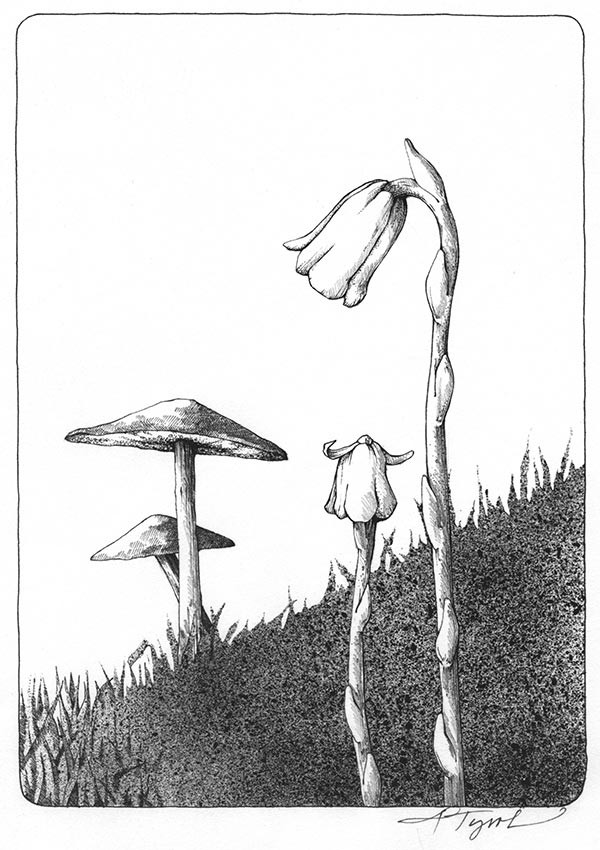
Where the long, slant rays are beaming,
Where the shadows cool lie dreaming
Pale the Indian pipes are gleaming — Sarah Foster Davis, Summer Song
On a walk in the woods in early fall, you may see a cluster of waxy, white stems with tiny, scale-like leaves rising out of the leaf litter or pine needles. At the end of each translucent stem is an odd, bell-shaped flower. This is Indian pipe, named for its resemblance to the clay pipes once smoked by Native Americans and early settlers.
Indian pipe, also known as corpse plant and ghost flower, has an unusual strategy for survival. It lacks the green pigment chlorophyll, and therefore cannot make its own food through photosynthesis as most plants do. Indian pipe and its relatives were formerly believed to live off decaying organic matter and were called saprophytes. However, more recent research has revealed that the plant is a parasite, sucking up nutrients from mycorrhizal fungi in the soil. Trees and mycorrhizal fungi have a symbiotic relationship: the fungi absorb nutrients from the trees; the trees benefit by increasing the surface area of their root systems, allowing them to drink in more water and minerals. Indian pipe interjects itself into this relationship, absorbing nutrients from the mycorrhizal fungi but giving nothing back.
Plants that feed on mycorrhizal fungi are called mycoheterotrophs, or sometimes just mycotrophs. These plants evolved from photosynthetic ancestors, but at some point in their history they abandoned that strategy. Many green plants such as orchids are mycotrophic during some phase of their life cycle, often when seedlings, and some continue to obtain some nutrients from fungi even as they grow larger and photosynthesize. Mycotrophic wildflowers are often specific about which fungus they feed on. For example, the snow plant of the Sierra Nevada is associated with just a single species of mycorrhizal fungi.
Other mycotrophic wildflowers found in our region include the tan or yellowish pinesap, which has a few flowers on each stem and taps into the roots of oaks or pines through a mycorrhizal intermediary; beech-drops, a parasite on the underground fungi in beech forests, which sport tiny purplish flowers on slender stems; and spotted coral-root, an orchid with a smooth purple stem and small purple and white flowers that grows in dry soils in a variety of forests. While these plants are all common, there are two rare species in the Northeast: the pinkish hairy pinesap and the autumn coral-root. All of these plants are easy to recognize because they have no green leaves, but unlike mushrooms, they have flowers. Since they don’t need sunlight, they can grow in dense shade.
For many years, the pollinators of Indian pipe were unknown. Recent research using remote video cameras has shown that bumblebees are major pollinators. Once the nodding white flowers are pollinated, they turn upwards, and the plant begins to turn brown or black. Each flower develops into a fruit – a dry capsule that encloses sawdust-like seeds. One day the capsule splits open and the tiny, winged seeds are dispersed by the wind. You can see the dry stalks of Indian pipe that remain through the winter.
The other-worldy appearance of Indian pipes has enchanted people for centuries. There are Native American stories of its origin and the plant has inspired several poets. The Indian pipe was one of Emily Dickinson’s favorite flowers and appeared on the cover of her first book of poetry. Nineteenth century writer and educator Catherine Esther Beecher (sister of Harriet Beecher Stowe) wrote To the Monotropa, or Ghost Flower:
Pale, mournful flower, that hidest in shade
Mild, dewy damps and murky glade,
With moss and mould,
Why dost thou hang thy ghastly head,
So sad and cold?
Look for these unusual plants on your next walk in the forest.


Discussion *